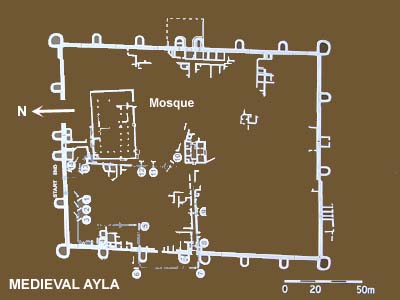Hydraulic System
Amra, Jordan
Amra was supplied by a 40m-deep ground-water well (photo center, behind arch). The water was pumped to a large holding tank behind the well, and distributed from there to the baths. This photo shows the pumping mechanism. A horizontal wood beam (waist height, photo center) is attached to the vertical shaft. Plodding around in a circle, a tethered animal would push the beam, which turned the vertical shaft, which was geared to the horizontal shaft, which turned the windlass, which raised water from the well.
français.......................................................................................................................................................
Système hydraulique
Amra, en Jordanie
Amra a été fourni par un 40m de profondeur des eaux souterraines ainsi (photo au centre, derrière arc). L'eau était pompée dans un réservoir de grande exploitationderrière le puits, et distribué à partir de là aux bains. Cette photo montre le mécanisme de pompage. Une poutre de bois horizontal (hauteur de la taille, un centre de photo) est fixé à l'arbre vertical. Laborieux autour d'un cercle, un animal captif serait pousser lefaisceau, qui a transformé le puits vertical, qui a été axée sur l'arbre horizontal, qui a transformé le guindeau, qui a soulevé l'eau du puits............................
italiano........................................................................................................................................................
Impianto idraulico
Amra, Jordan
Amra è stato fornito da un 40-deep terra-acqua di pozzo (foto al centro, dietro arco).L'acqua è stata pompata in un serbatoio grande holding dietro il pozzo, e distribuito da lìai bagni. Questa foto mostra il meccanismo di pompaggio. Una trave orizzontale(altezza della vita, foto centro) è fissato all'albero verticale. Arrancando intorno in uncerchio, un animale legato avrebbe spinto la trave, che ha trasformato l'albero verticale, che è stata orientata verso l'asse orizzontale, che si rivelò il verricello, che ha sollevatol'acqua dal pozzo.
español........................................................................................................................................................
Sistema hidráulico
Amra, Jordania
Amra fue suministrada por uno de 40 m de profundidad
del suelo-agua de pozo (foto
del centro, detrás
del arco). El agua se bombea a un tanque de almacenamiento de gran tamaño detrás
del pozo, y se distribuye desde allí a los baños. Esta foto muestra elmecanismo de bombeo. Una viga de
madera horizontal (altura de la cintura, la fotocentro) está unido al eje vertical. Perseverante alrededor de un círculo, un animal atadoque empujar la viga, que se convirtió el eje vertical, que estaba orientado en el ejehorizontal, que se convirtió el molinete, lo que elevó el agua
del pozo.
Deutsch.......................................................................................................................................................
Hydraulik-System
Amra, Jordanien
Amra wurde von einem 40 Meter tiefen Boden-Wasser-Brunnen (Foto Mitte, hinterBogen) geliefert. Das Wasser wurde zu einem großen Vorratstank hinter dem Brunnengepumpt und von dort aus verteilt zu den Bädern. Das Foto zeigt denPumpmechanismus. Ein horizontaler Holzbalken (Hüfthöhe, Foto Mitte) ist an der vertikalen Achse befestigt. Plackerei im Kreis herum, würde eine gefesselte Tierschieben Sie den Strahl, der die vertikale Achse gedreht, die auf die horizontale Achseausgerichtet wurde, die die Winde, die Wasser aus dem Brunnen erhoben sich.
ελληνικά.....................................................................................................................................................
Υδραυλικό Σύστημα
Amra, Ιορδανία
Amra δόθηκαν από 40μ-βαθιά στα υπόγεια ύδατα και (φωτογραφία κέντρο, πίσω απόαψίδα). Το νερό αντλείται σε μια μεγάλη δεξαμενή εκμετάλλευση πίσω από το καλά, καιαπό εκεί διανέμεται στα λουτρά. Αυτή η φωτογραφία δείχνει το μηχανισμό άντλησης. Έναοριζόντιο δοκάρι ξύλο (το ύψος της μέσης, φωτογραφία κέντρο) επισυνάπτεται στονκάθετο άξονα. Βραδυκίνητοι γύρω σε έναν κύκλο, ένα δεμένο ζώο θα ωθήσει τη δέσμη, η οποία μετέτρεψε το κάθετο άξονα, η οποία είχε στόχο τη οριζόντιο άξονα, ο οποίος γύρισετην εργάτης, ο οποίος έθεσε το νερό από το πηγάδι.
العربية...........................................................................................................................................................
النظام الهيدروليكي
عمرة، الأردن
تم تزويد عمرة من بئر الماء البالغ عمقه 40 م.(الصوره الوسطى وراء القوس). المياه كانت تضخ الى خزان كبير خلف البئر و يتم توزيعها من هناك الى الحمامات هذه الصوره تظهر ألية الضخ.عارضة الخشب الأفقية متصله مع العارضه العاموديه في الفتحه العاموديه.
تحول الحركه بشكل دائري, و حيوان مربوط ليدفع العارضه , التي سوف تدير العارضه العاموديه التي ستوجه العارضه الأفقيه, التي ستحول ألة الرفع لترفع الماء من البئر.




























